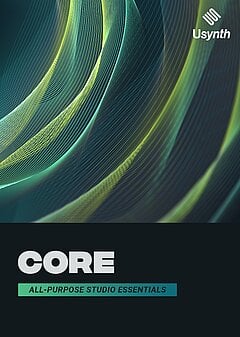The Ultimate Guide to Dubstep
How to design the perfect bass sound, create hard-hitting drums and keep listeners on the edge of their seats.
AUGUST 27TH, 2022
We uncover why BERSERK is an all-in-one solution for creating complete dubstep beats instantly. Read this article if you’d like to learn how to inject raw power into your drums:
Composition
If you find that you enjoy sound design more than writing melodies and harmonies, and you enjoy grittiness, hard-hitting drums and biting basses, dubstep is the perfect genre to explore. Some producers can get away with little or even zero melodic content and create incredible songs, specifically because they have incredible skill in both sound design and control over the dramatic arc of their songs.
There’s no single dramatic arc to always follow, but there are certain guidelines that should prove helpful. The most obvious one is that in dubstep, the drop is king — it should always have the most energy and aggression, which is ruled by the bass and drums. A powerful buildup must precede the drop, and its primary function is to create excitement for the climax of the song (or one of them if you have multiple drops). Typically this means starting a buildup with low excitement, building to a peak and then bringing in negative space or near silence, possibly with a drum fill to take it home.
Outside of buildups and drops, you can use a stand intro - verse - chorus structure, which is your primary opportunity to showcase your musical abilities. This is optional, however, as the verse can simply serve as a preview of what’s to come in the drop. You can also get super bare-bones and have no chorus at all, which allows you to focus more on the drops (and have more of them). Regardless of which you choose, the key lies in successfully building anticipation leading into the drop, paying it off, then releasing it afterward until the next rise in energy. If you can master this and your sound design skills are solid, you have the makings of a great dubstep producer!
Basses
Dubstep lives and dies by its bass design, so if there’s one area to focus the majority of your effort, this is it. There are several ways to create the core sound: One common option is creating wavetables and modulating their shape, and you can find a detailed description of this process in our companion article, How to Create Huge Bass Sounds. If you’re designing your bass from scratch, following the guidelines outlined there will help you stay on track and obtain excellent results.
Some producers prefer the “old school” option, which is truly building from scratch with FM synthesis. This is where you modulate one signal’s frequency with another waveform at audio rate (typically somewhere above 40Hz), which creates new frequencies called sidebands. By using different waveforms, frequencies and modulation depths, you can build complex sounds out of simple ones. This takes a significant amount of practice and study to understand, but if you’re passionate about sound design, this process is well worth the effort to learn. One important note that will save you a lot of time: Keep your bass notes an octave or even two below where you think they should be. You’ll get tons of rich harmonics that way and create much thicker bass sounds! From there, add some additional energy with heavy distortion, and you can quickly transform simple mechanical sounds into dubstep bass powerhouses.
Of course, if you want the most reliable and consistent tool for generating pro-quality bass sounds, look no further than Usynth CORE— there’s a massive library of bass sounds you can use, tweak, and process to your heart’s content without having to start from scratch!
Drums
If you’re used to creating “tamer” genres of EDM like house, electro or drum & bass, one of the biggest mentally shifts you’ll need to make is how much power to inject into your kicks and snares. They need to be big enough that when you sidechain the rest of your mix off of the kick and snare, the dead space is fully occupied by these samples and the mix still feels full. In practice, this implies a few specific treatments you’ll want to apply to your drums.
For your kicks, you’ll want them to occupy nearly the entire frequency spectrum. The bass should have a heftiness to it, and the high end must be crisp and punchy. Unless you’re starting with a sample that already checks all the boxes, you’ll have to do a bit of layering to achieve the right sound. To create the bottom end, use a sine wave that rapidly falls in pitch to a low bass note (generally 100Hz or lower), and use a volume envelope that quickly cuts off the final pitch so you don’t hear a clear tone lingering at the end (dubstep kicks should feel “dry”). Layer a couple high-frequency clicks with short tails — closed hi hats, mechanical clicks and short noise bursts can all be great sources for this. From there, compress and/or distort the layers together as needed and tweak until you get the result you want!
Snares involve a similar process, but using a sine sweep with less high frequency content and more tonal bottom, typically around 200Hz. To provide the necessary weight, you can even boost the bottom end with an EQ. Next, layer in a burst of noise with a long tail, faded in so as not to interfere with the transient. To give the transient some extra oomph, use a click layer to support the sine sweep — you can often use similar click sources for kicks and snares as they share many of the same needs! To bring it all together, load up a distortion plugin and drive all the layers together heavily; the distortion module you choose will have a massive influence on the sound, so play around with some options first.
From there, it’s relatively simple to add in hi hats and splash cymbals to fill in the space between the drums. If you want powerful dubstep drums but would prefer to get to the desired result faster, check out Beatmaker BESERK — this plugin is an all-in-one solution for creating complete dubstep beats instantly, without the limitations of audio loops or scrolling endlessly through sample packs that have a couple of good options at most!
Wrapping up
If your primary interest lies in sound design, dubstep contains an unending wealth of options for you to explore. Get the bass, drums and dramatic arc just right, and everything else will fall into place with little effort. Since the quality of your sounds is especially important for achieving a professional sound, Usynth CORE (bass) and Beatmaker BESERK (drums) are invaluable tools to accompany you on the journey. With them, you’ll never have to start from scratch, making the compositional process much easier every time you sit down at your DAW!
About the Author
Harry Lodes is a copywriter, marketing consultant and content writer for audio and ecommerce brands. He lives in the Philadelphia area, releasing Eastern/Western hybrid EDM under the artist name KAIRI hearkening back to his roots in Berklee College of Music.
Stay Up To Date
Sign up and we’ll send you an e-mail with product news and helpful stuff every now and then.
Defy Limits
We develop software solutions that enable people to create, consume and interact with music.





